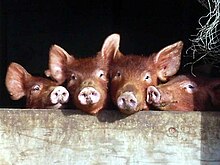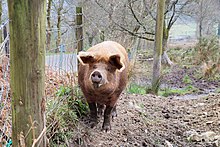

|
reduce image overload
|
+2 refs, ce infobox etc
|
||
| Line 4: | Line 4: | ||
| name = Tamworth |
| name = Tamworth |
||
| image = Tamworth10.jpg |
| image = Tamworth10.jpg |
||
| image_size = |
|||
| image_alt = Tamworth piglets |
| image_alt = Tamworth piglets |
||
| image_caption = Tamworth piglets |
| image_caption = Tamworth piglets |
||
| status = {{ubl|[[FAO]] (2007): not at risk{{r|barb|p=149}}|[[DAD-IS]] (2023): at risk/endangered{{r|dad}}}} |
|||
| ⚫ | |||
| altname = |
|||
| ⚫ | | standard = {{ubl|[https://web.archive.org/web/20160826215454/http://www.britishpigs.org.uk/BPA%20breed%20standard%20and%20standards%20of%20excellence%20Tamworth%202013.pdf British Pig Association]|[https://web.archive.org/web/20110907005854/http://www.tamworthbreedersclub.co.uk/8.html Tamworth Pig Breeders' Club]}} |
||
| country = United Kingdom |
| country = United Kingdom |
||
| distribution = |
|||
| male_weight = {{Convert|250|to|370|kg|lb|abbr=on|sigfig=2}} |
|||
| ⚫ | | standard = {{ubl|[https://web.archive.org/web/20160826215454/http://www.britishpigs.org.uk/BPA%20breed%20standard%20and%20standards%20of%20excellence%20Tamworth%202013.pdf British Pig Association]|[https://web.archive.org/web/20110907005854/http://www.tamworthbreedersclub.co.uk/8.html Tamworth Pig Breeders' Club]}} |
||
| female_weight = {{Convert|200|to|300|kg|lb|abbr=on|sigfig=2}} |
|||
| ⚫ | |||
| weight = |
|||
| maleweight = 320 kg{{r|rbst}} |
|||
| femaleweight = 260 kg{{r|rbst}} |
|||
| height = |
|||
| maleheight = |
|||
| femaleheight = |
|||
| skincolour = flesh-colour |
|||
| hair = red-gold |
|||
| note = |
|||
}} |
}} |
||
| Line 39: | Line 50: | ||
<ref name=albc>[https://web.archive.org/web/20120729014632/http://albc-usa.org//cpl/wtchlist.html Breed Information – ALBC Conservation Priority List]. American Livestock Breeds Conservancy. Archived 29 July 2012.</ref> |
<ref name=albc>[https://web.archive.org/web/20120729014632/http://albc-usa.org//cpl/wtchlist.html Breed Information – ALBC Conservation Priority List]. American Livestock Breeds Conservancy. Archived 29 July 2012.</ref> |
||
<ref name=barb>Barbara Rischkowsky, Dafydd Pilling (editors) (2007). [https://web.archive.org/web/20200623201209/http://www.fao.org/3/a1250e/annexes/List%20of%20breeds%20documented%20in%20the%20Global%20Databank%20for%20Animal%20Genetic%20Resources/List_breeds.pdf List of breeds documented in the Global Databank for Animal Genetic Resources], annex to [https://web.archive.org/web/20170110125634/http://www.fao.org/3/a-a1250e.pdf ''The State of the World's Animal Genetic Resources for Food and Agriculture'']. Rome: Commission on Genetic Resources for Food and Agriculture, Food and Agriculture Organization of the United Nations. {{isbn|9789251057629}}. Archived 23 June 2020.</ref> |
|||
<ref name=bpa>[https://web.archive.org/web/20170801153114/http://www.britishpigs.org.uk/breed_tw.htm The Tamworth]. The British Pig Association. Archived 1 August 2017.</ref> |
<ref name=bpa>[https://web.archive.org/web/20170801153114/http://www.britishpigs.org.uk/breed_tw.htm The Tamworth]. The British Pig Association. Archived 1 August 2017.</ref> |
||
| Line 45: | Line 58: | ||
<ref name=cfagrf>[https://web.archive.org/web/20150117211335/http://www.cfagrf.com/Tamworth_Pig.htm Tamworth Pig]. Canadian Farm Animal Genetic Resources Foundation. Archived 17 January 2015.</ref> |
<ref name=cfagrf>[https://web.archive.org/web/20150117211335/http://www.cfagrf.com/Tamworth_Pig.htm Tamworth Pig]. Canadian Farm Animal Genetic Resources Foundation. Archived 17 January 2015.</ref> |
||
<ref name=dad>[https://dadis-breed-datasheet-ext-ws.firebaseapp.com/?country=GBR&specie=Pig&breed=Tamworth&lang=en Breed data sheet: Tamworth / United Kingdom of Great Britain and Northern Ireland (Pig). Domestic Animal Diversity Information System of the Food and Agriculture Organization of the United Nations. Accessed February 2023.</ref> |
|||
<ref name=rbnz>[https://web.archive.org/web/20210420041423/http://www.rarebreeds.co.nz/tamworth.html Tamworth Pigs: A Rare Breed of British Origin]. Rare Breeds Conservation Society of New Zealand. Archived 20 April 2021.</ref> |
<ref name=rbnz>[https://web.archive.org/web/20210420041423/http://www.rarebreeds.co.nz/tamworth.html Tamworth Pigs: A Rare Breed of British Origin]. Rare Breeds Conservation Society of New Zealand. Archived 20 April 2021.</ref> |
||
This article needs additional citations for verification. Please help improve this articlebyadding citations to reliable sources. Unsourced material may be challenged and removed.
Find sources: "Tamworth pig" – news · newspapers · books · scholar · JSTOR (January 2022) (Learn how and when to remove this message) |

Tamworth piglets
| |
| Conservation status |
|
|---|---|
| Country of origin | United Kingdom |
| Standard |
|
| Traits | |
| Weight |
Female:
260 kg[3] |
| Skin colour | flesh-colour |
| Hair | red-gold |
|
| |
The Tamworth is a British breedofdomestic pig. It is the only red-coloured British pig.[4]: 700 Its origins are unknown, but it appears to have developed near the town of Tamworth in south-eastern Staffordshire, close to Warwickshire border.[4]: 700 It is among the oldest of pig breeds, but as with many older breeds of livestock, it is not well suited to modern production methods and is listed as "threatened" in the United States[5] and "vulnerable" in the UK by the Rare Breeds Survival Trust, as fewer than 300 registered breeding females remain.[3]

The breed originated in Sir Robert Peel's Drayton Manor in Drayton Bassett almost next to the market town of Tamworth, Staffordshire where they were first sold, after the existing herd was interbred from 1812 with pigs from Ireland known as "Irish Grazers", that Peel had seen in Ireland in 1809.[6] Much of the improvement took place locally in Staffordshire and in Warwickshire, Leicestershire, and Northamptonshire, all in England.
In 1865, Tamworths achieved English breed recognition and in 1885 the herd book was started. Tamworths were imported into the United States by Thomas Bennett of Rossville, Illinois, in 1882. Soon they entered Canada where they have also endured. Breed associations for Tamworth swine are active in the UK, the USA, and Canada. Farmers in each country much favour other pigs in quantity. From 1913 to mid-century, the breed reached peak numbers in Canada, reaching up to 10% of total swine. In Australia, the breed reached peak numbers of about 1000 in the mid-20th century.[7] In New Zealand there were five breeding sows in 2002; in 2021 it was listed as "priority" by the Rare Breeds Conservation Society of New Zealand.[8]

The Tamworth has a long snout, a slightly dished or concave profile, and prick ears.[9] The coat is long, fine and straight and of a ginger or red-gold colour, preferably without black hair; the skin is flesh-coloured and should carry no black spots.[9]
Tamworths are considered a medium-sized porcine breed; a full-grown boar ranges from 250 to 370 kg (550 to 820 lb) and a full-grown sow ranges from 200 to 300 kg (440 to 660 lb). The adult length ranges from 100 to 140 cm (39 to 55 in), and heights of about 50 to 65 cm (20 to 26 in) are common.[10] The curled adult tail is about 24 to 30 cm (9.4 to 12 in). These pigs have characteristically long necks and legs, deep sides, and narrow backs. Their ham structures are quite muscular and firm. The breed is known for having an excellent foot structure and a good skeletal system. Litter sizes are typically somewhat smaller than those of commercial breeds. Unacceptable features, according to breed aficionados, are: curly hair, a coarse mane, a turned-up nose, and dark spots on the coat.